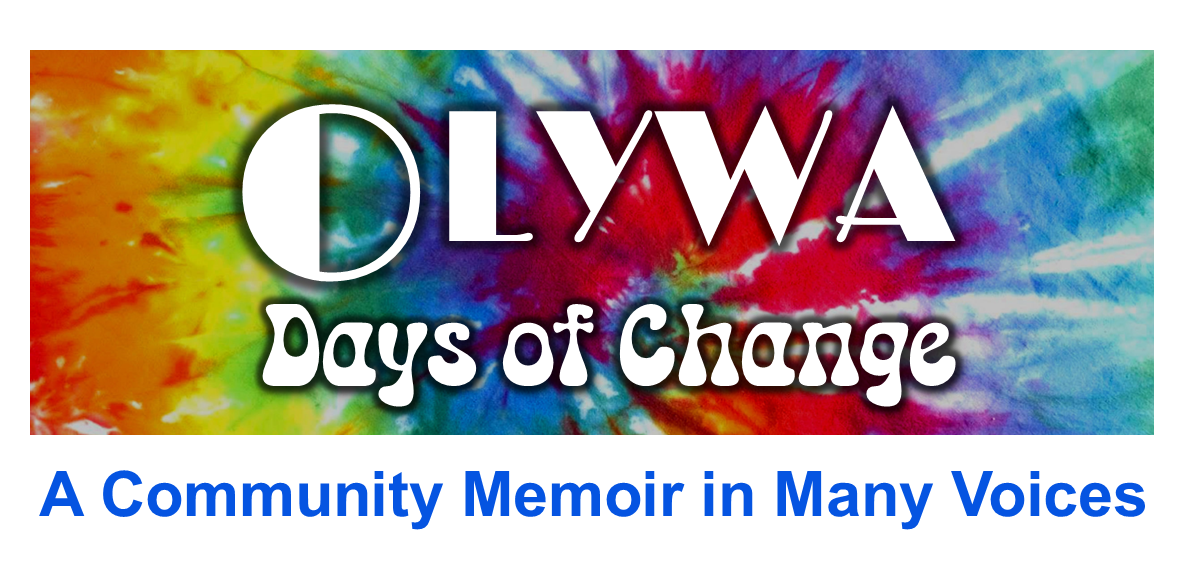ARRIVALS
Part 1: Finding My Place in the Universe
By LLyn De Danaan aka Lynn Patterson
I made the move. To Seattle. For graduate school at University of Washington. That’s why I was in the Pacific Northwest when The Evergreen State College opened.
Here’s what my life was like in the late 1960s while a student: Trips to the Pacific Ocean, driftwood, logging trucks, colorful flower-bedecked hitchhikers on freeway turn offs (on their way to San Francisco), light shows and strobes at Eagle’s Auditorium in Seattle, The Whole Earth Catalog, Helix (a brilliant “underground” newspaper), marching against the Vietnam War on the freeway and through downtown, buildings blowing up on campus, rallies at the federal courthouse, Radical Women meetings, Claire Fraser holding forth. I had the time of my life.

By 1970, I had nearly finished my graduate anthropology degree at University of Washington and had fallen in love with the Pacific Northwest. My decision to attend UW was driven by my heart and not half-imagined career goals. Yes, my specialty area was Southeast Asia. I had already lived in Sarawak, Malaysia for two years and written a couple of published papers based on research I was able to do even though I was a full time agricultural/Peace Corps worker. I knew Peter Wilson was at University of Washington and I wanted to study with him and further my work in Malaysia.
But the heart was the real decision maker. I had other choices for good graduate work. But I knew the Northwest was where I would want to spend my life. Since arriving in Seattle in 1966, I had worked with friends, Karen James and Bruce (Subiyay) Miller, on the Skokomish Reservation making a film with two elder basket makers, Louisa Pulsifer and Emily Miller. It was the beginning of a renaissance for Indigenous Northwest culture and politics. I knew my way around cameras and had studied visual anthropology at Ohio State. It was just one of many projects. I worked in Seattle on community development projects. I took on a collaborative project with farmworkers in the Yakima Valley. I visited logging camps and, with Karen’s family (my surrogate family), I learned to open oysters, dig razor clams and cook geoduck. Karen and her family had deep local roots: their forebears were immigrants from Finland and Cornwall, settled in the Grand Mound area. And Karen and Bruce welcomed me into a whole new world of Indigenous wisdom, culture, and craft.
I worked for a regional planning agency, our offices in the Ferry Terminal Building. I was in Seattle when the local movers and shakers saved the Public Market, and, because it was very much a “small” town and “small” state then, I met most politicians in Seattle and worked on several campaigns. One could move in and out of many circles easily.
I ate with grad student friends at Tai Tung on King Street. I taught in the Central District out of Herzl Synagogue and marveled when Seattle shut down after only an inch of snow had fallen and when people appeared in shorts if the sun came out for an hour or two in February. My leather shoes mildewed from the rain. By 1970, I was becoming a real Northwesterner and had a beginner’s grasp of what this wonderful western Washington was all about.
My brother, an 18-year-old conscientious objector, still in our family home in Beavercreek, Ohio, followed me to Seattle to serve his two years as an orderly with Harborview Hospital on First Hill. For a while, he lived with a friend and a goat and blacklight posters. By 1970, he had a spouse, Ellen, and my first niece, Callie.
***
I wanted to stay in this fabulous region! And during my graduate years, I and other teaching assistants began to deplore our status and the way we and others were taught. In between the rallies and the marches, we read Teaching as a Subversive Activity and other publications that envisioned a different kind of education and its purpose. When I heard about Evergreen, a new college that seemed to offer opportunities for real innovation, I couldn’t apply quickly enough.
It wasn’t easy to get an interview with anyone at Evergreen. Thousands of candidates from around the country sent inquiries. I traveled frequently to Olympia from my Wallingford neighborhood digs and brashly called Dean Cadwallader’s office each time. “I’m in town. I can come in today.” I would not be deterred. Finally, an invitation.
The campus was mud and machinery with a few pillars of concrete here and there. Staff and deans were in trailers on the property. The scent of something grand was in the air. I was pretty full of myself, I suppose, and had a resume that included pages of accomplishments and stellar academic references. The two entries on the resume that attracted attention were these: I had been told that I, “handle flip charts deftly,” by one of my bosses, and I had been the Ohio State Fair square dance calling champion. Never mind my time abroad in the Peace Corps, my Phi Beta Kappa, my research projects. It was those goofy exploits that the planning faculty asked me about during rounds of interviews (though one sullenly asked if I were “one of those feminists”). Nobody seemed to mind that I had been fired three times. Because the reasons I’d been fired had to do with my righteous stands on this and that, I assumed I would be at Evergreen for at most three years. I had to be ready to be asked to leave, so I didn’t go into debt for years.
We encourage readers to use the form below to make comments and suggestions. Disclaimer
